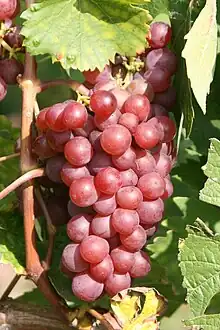| Schönburger | |
|---|---|
| Grape (Vitis) | |
 Schönburger in Weinsberg | |
| Color of berry skin | Rose |
| Species | Vitis vinifera |
| Also called | Schoenburger |
| Origin | Germany |
| Notable regions | Germany, UK and United States |
| Notable wines | Varietal wine |
| VIVC number | 10833 |
Schönburger, also spelled Schoenburger, or Schonburger is a variety of grape, formally designated Geisenheim 15–114, a crossing developed at Geisenheim Institute for Grape Breeding in Germany, and released in 1979, of Pinot noir x (Chasselas x Muscat Hamburg).[1]
It is grown now in Germany, as well as in England where it is gaining popularity in the early 2000s and is "authorized". It can also be found in British Columbia Canada,[2] and in western Washington state,[3] western Oregon state,[4] USA. A common feature of these areas is a cool climate, often maritime influenced. This is a reliable early-ripening grape,[5] though is susceptible to powdery mildew.[6]
The wine produced is typically a soft while full and fruity white.
Also planted in Tasmania Australia and New Zealand. An early ripening grape very similar to Gewürztraminer. Beautiful eating grape, a vigorous grower. [7]
References
- ↑ Winegrape Glossary
- ↑ :. British Columbia Grapegrowers Association .: Archived 2007-08-26 at the Wayback Machine
- ↑ Wine Grapes
- ↑ Sineann Winery
- ↑ "Wine Grape Report 2004". Archived from the original on 2007-08-13. Retrieved 2007-07-22.
- ↑ Grape Powdery Mildew
- ↑ NZ Grapevine Improvement Group Inc.
Barringwood Winery, Devenport TAS